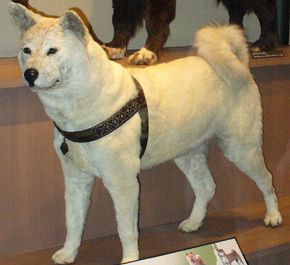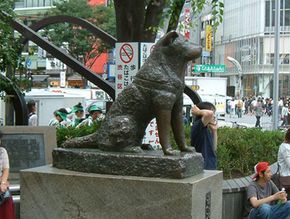 “The mounted remains of Hachiko, on display at the Museum of Nature and Science in Tokyo. See more dog images.Courtesy Muramasa
“The mounted remains of Hachiko, on display at the Museum of Nature and Science in Tokyo. See more dog images.Courtesy Muramasa
Even if you’re strictly a bona fide cat lover, it’s nearly impossible not to be moved by the brand of loyalty unique to dogs. Buddhists believe that on the day that the Buddha died, he summoned all animals to his side. Only members of 12 species — dogs among them — reached him before his death. He rewarded those who came with a year of their own, which is why the cat has no sign in the Chinese zodiac.
Although not every dog is necessarily friendly by nature, stories emerge from time to time of a dog becoming separated from his or her family and undertaking an incredible journey toward reunion. Dogs are used in therapy for Alzheimer’s disease and in clinical settings as comfort for the terminally ill. And consider this: Between Jan. 19 and Jan. 31, 2008, no fewer than five different families in the United States and Canada were saved by their dogs when their homes caught fire. All of this substantiates the old saying that dogs are man’s — and woman’s — best friend.
One breed of dog is especially prized for its fierce loyalty. The Akita is a fluffy dog that favors its wolf ancestors, with pointed ears that stand on end, a slightly scrunched face, and a tail that curls in a loop back toward its body. It hails from the Akita region of Japan, a prefecture (or state) in the north of the island. Originally all light in color, the Akita was first mentioned in Japanese literature around A.D. 712, and is depicted on much older pottery excavated in that country.
Hellen Keller asked for and was given an Akita after she toured the country in 1937 and learned the story of Chu-ken Hachiko (in Japanese, "faithful dog Hachiko") [source: Dog and Kennel].
Are dogs humankind’s best friends? The answer is a subjective one, but the story of Hachiko that inspired Helen Keller to adopt an Akita may be the closest we can get to objective evidence. Learn why Hachiko became Japan’s adopted national dog, on the next page.
Hachiko and Eisaburo
 “A statue of Hachiko, erected at the Shibuya train station in 1948.Michael Springer/Getty Images
“A statue of Hachiko, erected at the Shibuya train station in 1948.Michael Springer/Getty Images
The yellow-coated Akita named Hachiko was born in November 1923 in the province that is the namesake of his breed. A few months after his birth, little "Hachi" (as he came to be called) was brought to the home of Professor Eisaburo Uyeno (or Ueno) in Tokyo. The two became fast friends. Each morning, Hachiko accompanied his master to the Shibuya train station. Uyeno taught at the Imperial University, and Hachiko made it his habit to see his master off. Each evening, Hachiko returned to the train station, and when Uyeno got off the train, he found his dog awaiting his arrival, tail wagging happily at the sight of his owner and friend.
The pair continued their daily routine until May 1925, when Uyeno didn’t return on the usual train one evening. The professor had suffered a stroke at the university that day. He died and never returned to the train station where his friend was waiting.
Hachiko was given away after his master’s death, but he routinely escaped, showing up again and again at his old home. After time, Hachi apparently realized that Professor Uyeno no longer lived at the house. So he went to look for his master at the train station where he had accompanied him so many times before. Each day, Hachiko waited for Uyeno to return. And each day he didn’t see his friend among the commuters at the station.
The permanent fixture at the train station that was Hachiko attracted the attention of other commuters. Many of the people who frequented the Shibuya train station had seen Hachi and Professor Uyeno together each day. Realizing that Hachiko waited in vigil for his dead master, their hearts were touched. They brought Hachiko treats and food to nourish him during his wait.
News of Hachiko’s remarkable loyalty eventually made its way outside of Tokyo, and he became something of an iconic figure in Japan. A statue of Hachiko forged by sculptor Ando Teru was erected at the train station in 1934, where Hachiko had been awaiting his master’s return each day for nearly 10 years. During that time, he had come down with mange, fended off numerous street mongrels and contracted heartworms. Despite all of the hardships he encountered, he continued to wait.
On March 8, 1935, Hachiko laid down to die in the spot where he had spent a decade waiting each day for Uyeno to come home [source: The Tribune]. His bones were buried next to his master’s grave.
Hachiko’s death was mourned by his nation. As Japan entered World War II, and all metals became precious, however, sentimentality gave way to practicality. The statue of Hachiko was removed from its pedestal and melted for use as arms in April 1944.
After the war, a group of Tokyo residents commissioned Ando Takeshi, the son of the original statue’s sculptor, to create a replacement. It was erected in 1948, and it sits at the train station today.
Travel writer Cheri Sicard wrote of a man she encountered at this statue at Shibuya station. "During my last visit with ‘Hachi,’ I encountered an old man who had also come to pay his respects. He told me in broken English, ‘I knew him. I used to bring him treats’ … With that he approached the statue, gave it a friendly pat, wiped a tear from his eye and slowly walked away" [source: Sicard].
For more information on dogs, and other related topics — like cats — be sure to visit the next page.
Lots More Information
Related Articles
- How Dogs Work
- How Nirvana Works
- How Fire Works
- How Dog Training Works
- How Sled Dogs Work
- Dog Quiz
More Great Links
- Akita Rescue Society of America
- American Kennel Club: Akita Breed
- Video of an Akita Playing with a Kitten
- National Museum of Nature and Science, Tokyo
Sources
- Beauchamp, Rick. "The Akita Inu: The voice of Japan." Dog and Kennel. http://www.petpublishing.com/dogken/breeds/akita.shtml
- Haines, Rebecca. "Dog saves family of 4." Carthage Press. February 11, 2008. http://www.carthagepress.com/news/x1107268112
- Koyama, Rev. Dean. "Does a dog have Buddha nature?" Mountain View Buddhist Temple. http://www.mvbuddhisttemple.org/home/index.php?option=com_ content&task=view&id=5&Itemid=6
- Marien-de Luca, Catherine. "Akita Inu." Canine Information Library. http://www.bulldoginformation.com/Akita-inu.html
- North, Lucy, translator. "Hachiko: The Akita who became a symbol of loyalty." Akita Learning Center. http://www.northlandakitas.com/hachiko.htm
- Phillip, A.J. "Waiting for Uyeno." The Tribune Magazine. December 23, 2006. http://www.tribuneindia.com/2006/20061223/saturday/main1.htm
- Sicard, Cheri. "The story of Hachiko, Japan’s most faithful dog and the Tokyo statue in his honor." Fabulous Travel. 2007. http://www.fabuloustravel.com/globe/hachiko/hachiko.html
- Smith, Jane. "Dog saves owners in house fire." KWG. January 19, 2008. http://www.kgw.com/news-local/stories/kgw_011908_news_ dog_saves_family.3b8dc0ce.html
- Smith, Kevin M. "Dog saves couple, perishes in fire." Killeen Daily News. January 30, 2008. http://www.kdhnews.com/news/story.aspx?s=22535
- Tropea, Martha. "Dog saves couple, leads them to cash windfall." CanWest News Service. January 31, 2008. http://www.canada.com/vancouversun/news/westcoastnews/ story.html?id=bebb2a6b-7901-48dc-ae5b-e453667317c7
- Wylie, Katie. "Alzheimer’s pet-therapy trial a success." Stuff. February 18, 2008. http://www.stuff.co.nz/4405885a10.html
- "Dog saves family in burning house." KTVB. January 25, 2008. http://www.ktvb.com/news/localnews/stories/ktvbn-jan2508-dog_ saves_family.5876a243.html


